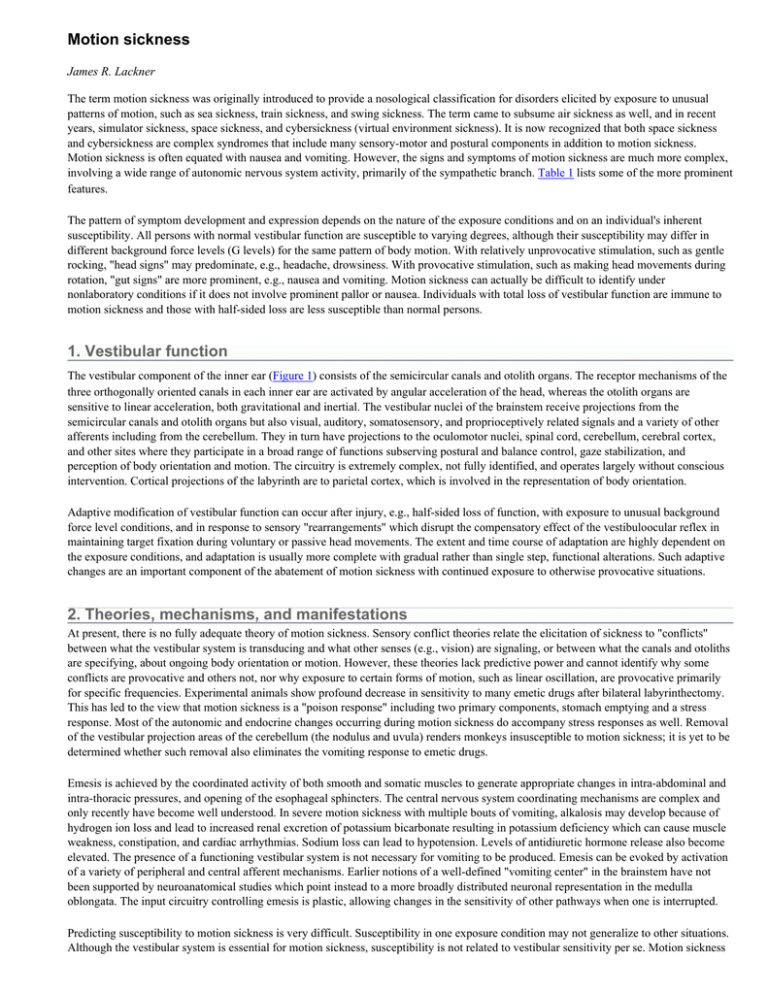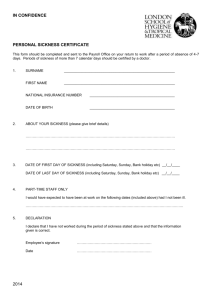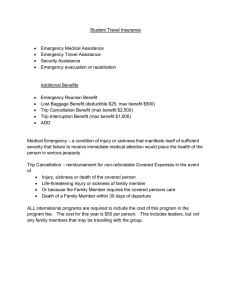
Motion sickness
James R. Lackner
The term motion sickness was originally introduced to provide a nosological classification for disorders elicited by exposure to unusual
patterns of motion, such as sea sickness, train sickness, and swing sickness. The term came to subsume air sickness as well, and in recent
years, simulator sickness, space sickness, and cybersickness (virtual environment sickness). It is now recognized that both space sickness
and cybersickness are complex syndromes that include many sensory-motor and postural components in addition to motion sickness.
Motion sickness is often equated with nausea and vomiting. However, the signs and symptoms of motion sickness are much more complex,
involving a wide range of autonomic nervous system activity, primarily of the sympathetic branch. Table 1 lists some of the more prominent
features.
The pattern of symptom development and expression depends on the nature of the exposure conditions and on an individual's inherent
susceptibility. All persons with normal vestibular function are susceptible to varying degrees, although their susceptibility may differ in
different background force levels (G levels) for the same pattern of body motion. With relatively unprovocative stimulation, such as gentle
rocking, "head signs" may predominate, e.g., headache, drowsiness. With provocative stimulation, such as making head movements during
rotation, "gut signs" are more prominent, e.g., nausea and vomiting. Motion sickness can actually be difficult to identify under
nonlaboratory conditions if it does not involve prominent pallor or nausea. Individuals with total loss of vestibular function are immune to
motion sickness and those with half-sided loss are less susceptible than normal persons.
1. Vestibular function
The vestibular component of the inner ear (Figure 1) consists of the semicircular canals and otolith organs. The receptor mechanisms of the
three orthogonally oriented canals in each inner ear are activated by angular acceleration of the head, whereas the otolith organs are
sensitive to linear acceleration, both gravitational and inertial. The vestibular nuclei of the brainstem receive projections from the
semicircular canals and otolith organs but also visual, auditory, somatosensory, and proprioceptively related signals and a variety of other
afferents including from the cerebellum. They in turn have projections to the oculomotor nuclei, spinal cord, cerebellum, cerebral cortex,
and other sites where they participate in a broad range of functions subserving postural and balance control, gaze stabilization, and
perception of body orientation and motion. The circuitry is extremely complex, not fully identified, and operates largely without conscious
intervention. Cortical projections of the labyrinth are to parietal cortex, which is involved in the representation of body orientation.
Adaptive modification of vestibular function can occur after injury, e.g., half-sided loss of function, with exposure to unusual background
force level conditions, and in response to sensory "rearrangements" which disrupt the compensatory effect of the vestibuloocular reflex in
maintaining target fixation during voluntary or passive head movements. The extent and time course of adaptation are highly dependent on
the exposure conditions, and adaptation is usually more complete with gradual rather than single step, functional alterations. Such adaptive
changes are an important component of the abatement of motion sickness with continued exposure to otherwise provocative situations.
2. Theories, mechanisms, and manifestations
At present, there is no fully adequate theory of motion sickness. Sensory conflict theories relate the elicitation of sickness to "conflicts"
between what the vestibular system is transducing and what other senses (e.g., vision) are signaling, or between what the canals and otoliths
are specifying, about ongoing body orientation or motion. However, these theories lack predictive power and cannot identify why some
conflicts are provocative and others not, nor why exposure to certain forms of motion, such as linear oscillation, are provocative primarily
for specific frequencies. Experimental animals show profound decrease in sensitivity to many emetic drugs after bilateral labyrinthectomy.
This has led to the view that motion sickness is a "poison response" including two primary components, stomach emptying and a stress
response. Most of the autonomic and endocrine changes occurring during motion sickness do accompany stress responses as well. Removal
of the vestibular projection areas of the cerebellum (the nodulus and uvula) renders monkeys insusceptible to motion sickness; it is yet to be
determined whether such removal also eliminates the vomiting response to emetic drugs.
Emesis is achieved by the coordinated activity of both smooth and somatic muscles to generate appropriate changes in intra-abdominal and
intra-thoracic pressures, and opening of the esophageal sphincters. The central nervous system coordinating mechanisms are complex and
only recently have become well understood. In severe motion sickness with multiple bouts of vomiting, alkalosis may develop because of
hydrogen ion loss and lead to increased renal excretion of potassium bicarbonate resulting in potassium deficiency which can cause muscle
weakness, constipation, and cardiac arrhythmias. Sodium loss can lead to hypotension. Levels of antidiuretic hormone release also become
elevated. The presence of a functioning vestibular system is not necessary for vomiting to be produced. Emesis can be evoked by activation
of a variety of peripheral and central afferent mechanisms. Earlier notions of a well-defined "vomiting center" in the brainstem have not
been supported by neuroanatomical studies which point instead to a more broadly distributed neuronal representation in the medulla
oblongata. The input circuitry controlling emesis is plastic, allowing changes in the sensitivity of other pathways when one is interrupted.
Predicting susceptibility to motion sickness is very difficult. Susceptibility in one exposure condition may not generalize to other situations.
Although the vestibular system is essential for motion sickness, susceptibility is not related to vestibular sensitivity per se. Motion sickness
can be induced, for example, by motions that stimulate separately or in combination the semicircular canals and otolith organs of the inner
ear, moving patterns of visual stimuli, or the voluntary override of reflexive eye movements. Artificial alteration of the effective gain of the
vestibuloocular reflex by means of lens systems readily induces symptoms until adaptive compensations are made. Head movements made
during passive body rotation produce a bizarre pattern of stimulation of the canals and otolith organs, "Coriolis cross-coupling stimulation,"
that is highly provocative under ground-based conditions, only mildly provocative under weightless conditions, and extraordinarily
provocative under conditions of increased background force level, e.g., high-G conditions. Individuals often vary in their susceptibility to
these different forms of stimulation. Almost all nonlaboratory situations that are provocative involve more than one etiological or
predisposing factor. This largely accounts for why it is difficult to generalize from laboratory assessments of susceptibility involving one or
a few factors to more complicated, natural exposure situations that can involve both passive and active head and body movements, and
voluntary locomotion.
Exposure to orbital space flight affects not only the otolith organs because of the effective lifting of the tonic 1 g acceleration of earth
gravity (owing to the free fall conditions) but also the entire pattern of sensory-motor control and support of the body. Such altered sensorymotor demands during head and body movement are provocative in themselves when mimicked under terrestrial conditions. It is not
surprising, therefore, that reports of motion sickness are commonplace with the use of virtual reality devices, which can produce alterations
in visuomotor control and in the apparent visual consequences of self-motion. Such cybersickness can be as disruptive during exposure to
virtual environments as space sickness is in space flight until adaptive compensation can be achieved. An important aspect of space motion
sickness and of cybersickness is what has become known as the sopite syndrome (from the Greek "sopor," for drowsiness). It refers to the
tiredness, mood swings, lack of initiative and apathy that can develop and persist during prolonged exposure to relatively unprovocative
situations. Under some conditions, and for some individuals, the sopite syndrome can be the primary or sole expression of motion sickness.
Its presence can be difficult to identify in nonlaboratory settings.
3. Preventing and treating motion sickness
Prevention of motion sickness and recovery from motion sickness can be complex. A small percentage of normal individuals are highly
susceptible for nearly all exposure situations, a small percentage are highly insusceptible, and most are in between. The best prevention for
the highly susceptible is avoidance. For other individuals, spaced exposure of short duration can lead to a buildup of adaptation to the
provocative situation. This is especially effective if only minor symptoms of motion sickness are allowed to develop before terminating
each exposure period. Alternatively, incremental exposure to gradually increasing levels of provocative stimulation (e.g., making head
movements during exposure to passive body rotation at higher and higher rotation velocities) can allow adaptation to be achieved without
motion sickness being elicited even at stressor levels that if achieved in a single step would be intolerably provocative.
Behavior modification techniques (biofeedback) have long been promoted as a way of preventing motion sickness. Some success has been
reported in laboratory conditions, but this rarely transfers to "real world" conditions where the trainer is absent. In addition, these studies
virtually never include appropriate controls for placebo effects. A variety of drugs are available to reduce susceptibility to motion sickness.
Over the counter drugs with some efficacy include dimenhydrinate (Dramamine®), meclizine (Bonine®), and cyclizine (Marezine®). The
prescription Transderm® patch can provide protection for 24 hours or more. The most effective antimotion sickness drugs, including the
relatively weak ones listed above, have adverse side effects, generally including drowsiness and dry mouth. More potent drugs and drug
combinations include scopolamine (often used in association with amphetamine, "Scopdex," to counteract sleepiness) and promethazine
(often with ephedrine). In cases of fully developed, high severe motion sickness, intramuscular injections of scopolamine or promethazine
may be necessary to provide relief. Effective anti-emetic drugs have anticholinergic, antihistaminic, or sympathomimetic properties;
however, not all of the central sites of action are understood, and they tend to be relatively unselective in their effects. New families of
receptor subtypes are being discovered that open the possibility of developing antimotion sickness drugs that block only certain types of
neurotransmitter binding sites, thereby leading to fewer undesirable side effects.
4. See also
Gravitational effects on brain and behavior
Vestibular system
Motion sense [Classic paper]
Autonomic nervous system: Nature and functional neuroanatomy
Visual-vestibular interaction
5. Further reading
DiZio P, Lackner JR (2002): Proprioceptive adaptation and aftereffects. In: Handbook of Virtual Environments, Stanney K, ed. New York:
Lawrence Erlbaum Associates, pp. 751-771.
Grelot L, Miller AD (1994): Vomiting- Its ins and outs. NIPS 9:142-147.
Lackner JR, Graybiel A (1994): Use of promethazine to hasten adaptation to provocative motion. J Clin Pharmacol 34:644-648.
[MEDLINE]
Money KE, Lackner JR, Cheung RSK (1996): The autonomic nervous system and motion sickness. In: Vestibular Autonomic Regulation,
Yates BJ, Miller AD, eds. Boca Raton, FL: CRC Press, pp. 147-173.
Previc FH (1996): Autonomic disturbances resulting from exposure to unusual gravitational environments. In: Vestibular Autonomic
Regulation, Yates BJ, Miller AD, eds. Boca Raton, FL: CRC Press, pp. 175-196.
Reason J, Brand J (1975): Motion Sickness. London: Academic Press.
Yates BJ, Miller AD, Lucot JB (1998): The physiological basis and pharmacology of motion sickness: An update. Brain Res Bull 47:395406. [MEDLINE]
Yates BJ, Holmes MJ, Jian BJ (2000): Adaptive plasticity in vestibular influences on cardiovascular control. Brain Res Bull 53:3-9
6. References
Anson BG, Harper DB, Winch TG (1968): Third Symposium on the Role of the Vestibular Organs in Space Exploration. NASA SP-152
Figure 1. Reconstruction of the membranous labyrinth and related anatomy. (From: Anson et al., 1968)
Table 1. Diagnostic elements of motion sickness
Nausea syndrome
Epigastric awareness
– Epigastric discomfort
– Nausea
– Vomiting
Skin signs
– Pallor
– Cold sweating
– Dry mouth
Central nervous system features
– Headache
– Dizziness
– Drowsiness
– Eye strain
– Apathy
Copyright © 2004 Elsevier B.V. All rights reserved.


